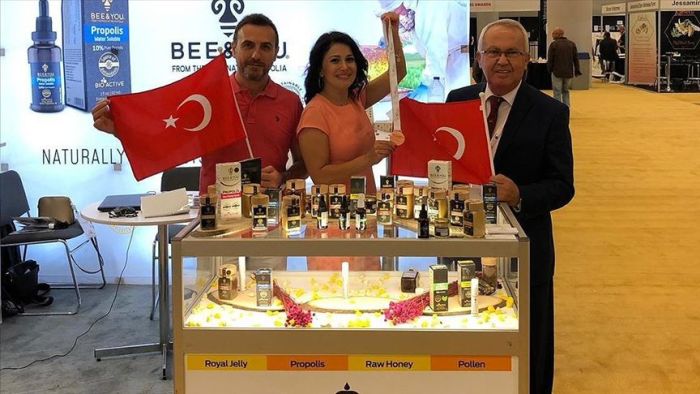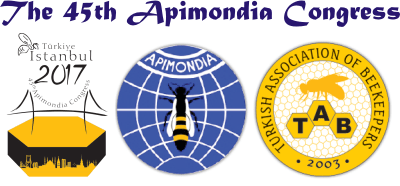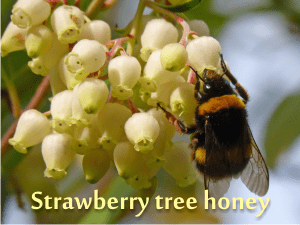The experts agreed: the bear is right. Turkish honey is the best honey in the world. At least for the year 2019. It is a trend now with Turkish honey… Elvish honey – the most expensive in the world (€5000/kg), Anzer honey – the tastiest (as confirmed by the bears), Mad honey – with medical and psychedelic properties, and now, a simple multifloral honey gets the highest prize!
And where is manuka honey placed? We all know it is the most appreciated honey, powerful enough to kill bacteria where current antibiotics fail. Isn’t this honey the best? Who gets to decide and under what criteria?
The prize of “the best” is given every 2 years at Apimondia – the World Congresses of the International Federation of Beekeeping Associations. Every time it is held in held a in different country. It’s the most popular of all honey manifestations. During this congress, experts gather and organize a contest for the title of “the best honey in the world”. And every other category related to beekeeping, aiming to highlight international excellence
for honey, bee products, bee inventions and materials related to beekeeping. The contest is known as WBA (World Beekeeping Awards).
The 46th Apimondia International Apicultural Congress 2019
Held in Montréal, Canada, at the Palais des congrès de Montréal, between 8th – 12th September 2019.
6,000 participants
80 countries
4 world luminaries
48 technical symposiums – 8 round tables and 9 general public workshops
World Beekeeping Awards
200 exhibitors at API EXPO
The congress included Apimondia Scientific Commissions and Symposia Topics on: beekeeping economy, bee biology, bee health, pollination and bee flora, beekeeping technology and quality, apitherapy, beekeeping for rural development. (There were over 940 abstracts from scientists engaged in cutting-edge research from around the world considered for inclusion in this year’s Congress.)
The organizers highlighted the progress of genomics in beekeeping science, the impact of pesticides on bees, the selection for resistance to house dust mites and diseases, the detection and prevention of honey fraud, conservation of pollinators, beekeeping without treatment, citizen science and bees.
The Round Table discussions were held concurrently with the symposia, offering participants to discuss current issues with visiting experts and scientists, as well as “cross-cutting” symposia, bringing two or more commissions together where areas of interest overlap.
There were over 260 oral scientific works and over 770 posters representing synthesis of other scientific papers. Apitherapy represented more than 1/5 of all presentations.
WBA AWARDS (World Beekeeping Awards)
WBA is a global contest of all things related to beekeeping. The participants had to submit their samples by 20th of July. The awarding ceremony was held on September 9, at the end of the day, at the Palais des Congrès in Montreal.
The participating categories included:
· honey,
· beeswax,
· mead and other honey beverages,
· cosmetics,
· medicines,
· best innovations and inventions for beekeeping,
· books and magazines in apiculture,
· artistic exhibits, and displays.
How was honey tested and evaluated:
All honey samples were tested for authenticity using Nuclear Magnetic Resonance (NMR) spectroscopy, thus eliminating all possible C4 and C3 sugars adulteration.
The laboratory analysis analysed the honey samples for moisture, invert sugar, saccharose, acidity, insoluble solids, artificial sweeteners, hydroxymethylfurfuraldehyde, carbon isotope ratio, presence of residual antibiotics etc.
Does that mean that we have found the best therapeutic honey of all?
No. For several reasons:
1. Not all the honeys in the world had been presented there. Some beekeepers consider this contest unnecessary, some don’t care, some can’t afford etc.
2. There are fluctuations in a honey’s quality, depending on the weather conditions. What was best this year,may have different characteristics the next year.
3. Some honeys taste horrible (yes, it is possible, see strawberry tree honey), yet have amazing health properties. At this contest, taste, smell, aroma, consistency – are all taking into consideration.
4. A type of honey with high concentration of minerals is good for anemia problems, but not for inflammatory ones. Powerful antimicrobial honeys (like manuka honey) are not powerful antioxidant ones (see Buckwheat honey – the most powerful antioxidant honey! And so on.
Their classification of best honeys does not imply they have found one honey good for every health problem.
What bee products participated in the contest?
The contest included Individual and Commercial classes:
Individual classes:
– run honey (not crystallized)
– set honey (naturally crystallized, not stirred)
– speciality honey (honey with added products such as cinnamon, nuts, dried fruits etc.)
– mead / honey beer / honey liqueur
– beeswax (plain and decorated candles)
– dispay
In addition to these, commercial classes also included cosmetics and medicines.
The judges were represented from each major Region of the World (Asia, Americas, Africa, Europe and Oceania). There were 2 or 3 judges in each judging committee, one of which was Head of that committee.
ApiEXPO – the Apiculture Exposition
ApiEXPO – the biggest beekeeping trade show included over 200 exhibitors: manufacturers of beekeeping equipment and attire, companies specializing in bee nutrition and hive technology, bee hive product and stock producers, as well as educational institutions and beekeeping associations. Everything was presented there: from the latest innovations in hive components and bee health products, to current advances in hive monitoring from companies around the world.
The Jury elected the best booths in the ApiExpo:
Smallest: Royal Bees – Bulgaria
Largest: Swienty – Denmark
And the winner of The Best Honey In The World is …
A polyfloral honey from Turkey. Just like that.
Çiçek Honey, produced by Egricayir Bal.
They received the title and the most prestigious, Carl and Virginia Webb Honey Bowl.
“Our family’s beekeeping tradition dates back to more than 300 years, we work hard to produce fine quality honey,” Celal Cay, the owner of Egricayir Bal, told Anadolu Agency after receiving the award.
Cay said the company also won a silver medal in a Kiev congress in 2013 and a gold medal in Istanbul in 2017.
So what is this Çiçek honey (aka bal, or bali – the Turk names for honey)?
In Turkish, Çiçek means “flower” and is often met as a surname of female name. Çiçek honey means polyfloral or multifloral honey.
Are flowers of Turkey so special?
Apparently so. Specialists say Turkey is like the heaven of flowers.
It contains three different phyto-geographic zones: European-Siberian, Mediterranean, and Iranian-Turanian, with 10.000 native plant species, of which 3.900 are endemic. Almost 500 plants are known to provide nectar or pollen, and nearly 50 of them are identified as dominant nectar plants. Turkey is well-known for its chestnut honey, thyme honey, mountain meadow honey (see Anzer honey), citrus honey, rhododendron honey and mixed flower honey.
In 2017, the 45th Apimondia Congress was held in Istanbul, Turkey. And, the first place for comb honey was awarded to DİLEK ÖZKAN from Turkey.
Turks are very serious when it comes to honey. During the Apimondia Congress, which btw was an enormous success, there were more than 13,000 participants from 128 countries and 350 exhibitors. Yes, this is more than this year, at Montreal.
First places for the other categories:
– light coloured, run (liquid) honey – Htwe Aung Khaing, MYANMAR
– Medium colored, run (liquid) honey – Papakostas Dimitris, CYPRUS and Savoy Jim, USA
– clear, dark coloured, run (liquid) honey – Santos da Silva Tarciano, BRAZIL and Santos da Silva Tarciano, BRAZIL
– naturally crystallised (not stirred) honey – Karaketov Kazim, KYRGYZSTAN
– soft set honey – Wendell Timothy, CANADA and Karaketov Kazim, KYRGYZSTAN
– cut comb honey max weight 300g – Muliukov Sergei, RUSSIA and Çelebi Halit, TURKEY
– honey with added products – Baldoni Me,l BRAZIL and Karaketov Kazim, KYRGYZSTAN
– sweet mead – Opalek Radoslav, SLOVAK REPUBLIC and Stefanak Josef, SLOVAK REPUBLIC
– Metheglin – Kudlac Peter, SLOVAK REPUBLIC
– Melomel – Bourke Lindsay, AUSTRALIA
– honey beer – Bourke Lindsay, AUSTRALIA
– honey liqueur – Kudlac Peter, SLOVAK REPUBLIC
– beeswax plain candles – Vargapal Tibor, SLOVAK REPUBLIC
– beeswax decorated candles – Muliukov Sergei, RUSSIA
– Lotion/Hand Cream – Trading House Bashkir Honey, RUSSIA
– Other cosmetic products – Tentorium LLC, RUSSIA
– Decorative display of bee products – Vargapal Tibor, SLOVAK REPUBLIC
– Honey for sale display – Vargapal Tibor, SLOVAK REPUBLIC
– One printed photograph A4 size – Nicholson-McKellar Mirabai, RUSSIA
– Beekeeping book with general interest to beekeepers – Filo Pavel, SLOVAK REPUBLIC
– Website or mobile app, related to beekeeping – Krawczyk Rafal, POLAND
– Video – theme: Beekeeping together within Agriculture – Lyson Tomasz, POLAND
– Decorative or artistic exhibit, relating to bees or beekeeping – Lyson Tomasz, POLAND
– Innovations – Lyson Tomasz, POLAND and BB Wear, UK
The Best Mead in 2019?
The winner for “The Best Mead” was RADOSLAV OPALEK – class 23 (2 bottle of sweet mead).
If you don’t know what mead is, please read this: This 9000 years old booze is back on top. Let’s all mead now! and other interesting article you can find here.
Where can we buy Cicek honey?

Being a general polyfloral honey, it is hard to say that if you buy cicek honey, you will have exactly that winning honey. You can find that type, harvested probably on the same fields and from the same wild flowers, on their site, unfortunately only in Turk.
You can also find some cicek honey from other producers on Amazon.com (#ad), Amazon.com.tr, Amazon.fr and Amazon.de.
But isn’t manuka honey the best honey of all?
As I said in other posts, some specific honeys are more recommended in certain conditions, than in others. The fact that manuka honey is well-known as the best antimicrobial honey, better than lots of other synthetic antibiotics, doesn’t makes it the best.
For example, here is a study proving that Turkish pine honey is equally valuable to Manuka honey.
– The study “Comparison of physicochemical and bioactive properties of turkish pine honey and New Zealand manuka honey”by U. Alpat et al. from Istanbul, tried to elucidate the dominant properties of Turkish pine honey over New Zealand manuka honey.
In the study there were determined the level of 43 different flavonoids and 13 minerals, as well as moisture, acidity, conductivity, diastase, invertase, proline, colour, HMF, sugar profile, total disaccharides and antimicrobial activity of the honey samples.
Methylsyringate, shikimic and quinic acid were the most abundant flavonoids detected in both varieties. Phenyllactic acid and t-cinnamic acid were detected only in manuka honey.
Amount of protocatechuic acid in Turkish pine honey was significantly higher than manuka honey.
Moisture and acidity values of both honey types were similar while the value of the diastase and invertase of pine honey were approximately two times higher than manuka honey.
The average conductivity value of Turkish pine honey is 1.12, while this value was 0.5 in Manuka honey.
Total disaccharides of manuka and pine honeys were 5,7% and 9,4% respectively.
The average amount of potassium in pine honey and manuka honey were 2866 mg/kg and 1095 mg/kg respectively.
The antibacterial activities of Turkish pine honey and Manuka honey were investigated against the reference strains using microdilution method. The Minimum Inhibition Concentration ( MIC) of Turkish pine honey against S.aureus varied between 3,12% and 25%, while the Manuka honey changed between 6.25% and 25%.
The MIC values of the honey types against E.coli ranged between 12.5% and 25% (w/V). According to the study Turkish pine honey showed higher antibacterial activity than manuka honey (UMF 10 +) against S.aureus and E.coli reference strains.
According to comparable analysis parameters, Turkish pine honey has better values of potassium, iron, zinc and protocatechuic acid while it has similar values of antioxidant capacity, methylsyringate and shikimic acid concentrations versus Manuka.
Manuka honeys with UMF values above 15+ showed higher antibacterial activity than Turkish pine honey against S.aureus and E.coli reference strains.
– Montane honey has also been shown to have the highest bactericidal and bacteriostatic properties, which makes it the best honey for pharmaceutical preparations. Other studies also found that 3 other honey samples have higher bactericidal property compared to Manuka honey with bioactivity grade of 20+. The honey samples having higher antibacterial property were found to have better antioxidant activity, due to diverse groups of phytochemicals.
References:
picture source






thanks